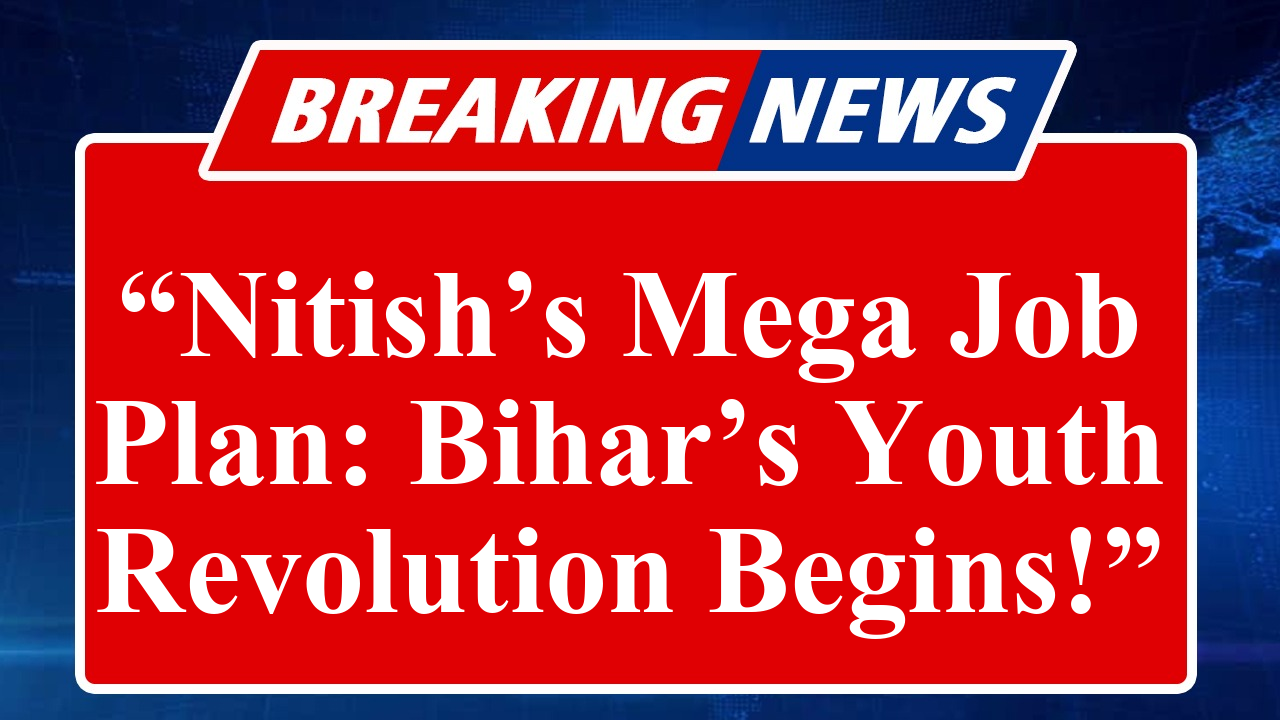Bihar Chief Minister Nitish Kumar announced a comprehensive plan on June 5, 2025, to address unemployment, targeting youth with cash incentives, internships, and self-employment schemes. The initiative includes ₹4,000–₹6,000 monthly stipends for educated youth and up to ₹10 lakh for startups. Aimed at curbing migration and boosting local economies, the plan has sparked debates amid the upcoming 2025 Bihar elections.
Nitish Kumar’s Ambitious Strategy to Uplift Bihar’s Jobless Youth
On June 5, 2025, Bihar Chief Minister Nitish Kumar launched a sweeping initiative to combat the state’s persistent unemployment crisis, a move seen as both a developmental push and a strategic play ahead of the 2025 assembly elections. The plan, rolled out during a high-profile event in Patna, focuses on empowering the state’s youth through a mix of financial incentives, skill-building programs, and entrepreneurial support, aiming to reduce Bihar’s reliance on outmigration for jobs.
The centerpiece of the initiative is a cash incentive scheme targeting unemployed youth aged 20–25. Under this, 12th-pass candidates will receive ₹4,000 per month, while diploma holders are eligible for ₹5,000, and graduates can avail ₹6,000 monthly for up to two years. This financial aid is designed to support youth in covering essential expenses like travel and sustenance while they seek employment opportunities. “This is about giving our young people the means to stay in Bihar and build their futures here,” Kumar said during the announcement, emphasizing the scheme’s role in curbing migration.
Additionally, the plan introduces an internship program to bridge the gap between education and employment. The state government will facilitate internships in both public and private sectors, offering practical exposure to enhance employability. Sources indicate that the initiative aims to cover at least 10 lakh youth over the next two years, with a budget allocation of ₹12,000 crore drawn from state funds and central government support.
To bolster self-employment, the Nitish Kumar-led government has also enhanced the Chief Minister’s Udyami Yojana, increasing the financial assistance for startups to ₹10 lakh per entrepreneur. This scheme, initially launched to promote small-scale industries, now includes mentorship programs and market linkages to ensure sustainability. “Our goal is to make Bihar’s youth job creators, not just job seekers,” Kumar stated, highlighting the state’s ambition to foster a startup ecosystem.
The announcement comes at a critical juncture, with Bihar’s unemployment rate remaining a pressing concern. According to 2023 data, the state’s urban unemployment stood at 10.2%, while rural areas reported 7.8%, both significantly higher than the national average. Critics, including Congress leader Sachin Pilot, have pointed to the state’s failure to attract large-scale private investment and its over-reliance on low-paying government jobs. The opposition’s ‘Palayan Roko, Naukri Do’ (Stop Migration, Provide Jobs) campaign, led by Kanhaiya Kumar, has gained traction, accusing the Nitish Kumar government of neglecting job creation for over two decades.
Despite the criticism, the ruling Janata Dal (United) defends its track record, citing the creation of 5.16 lakh jobs under the ‘Saat Nischay Part-2’ program by 2024. Supporters argue that Kumar’s latest plan builds on his earlier successes, such as the Jeevika project, which empowered rural women through cooperatives and financial services. The JD(U) has also leveraged recent infrastructure developments, like the double-decker flyover in Patna, to project an image of progress under the “double engine” government with the BJP-led NDA.
However, political analysts view the timing of the announcement as strategic, with the Bihar assembly elections looming in October–November 2025. Surveys, such as one conducted by Poll Tracker between March and June 2025, suggest growing dissatisfaction with the state government, with 50% of respondents seeking change. The opposition Mahagathbandhan, led by Tejashwi Yadav’s RJD, is projected to gain ground, potentially securing 126 seats compared to the NDA’s 112. Critics like CPI(ML) General Secretary Dipankar Bhattacharya have called the plan a “copycat” move, alleging it mimics opposition promises to woo voters.
The plan’s success hinges on its implementation, with challenges including bureaucratic inefficiencies and the state’s limited industrial base. While the government has promised swift rollout starting July 2025, skepticism persists about whether the initiative can deliver tangible results before the polls. Kumar’s supporters, however, remain optimistic, pointing to his track record of welfare schemes like the Kanya Utthan Yojana and pension hikes for the elderly and disabled.
As Bihar braces for a heated electoral battle, Kumar’s unemployment plan has sparked a mix of hope and debate. Whether it will reshape the state’s economic landscape or serve as an electioneering tool remains to be seen, but it underscores the urgency of addressing one of Bihar’s most enduring challenges.
Disclaimer: This article is based on reports, government announcements, and public data available as of July 5, 2025. Information is sourced from credible news outlets, including The Hindu, Hindustan Times, and posts on X. Readers are advised to verify details through official channels for the latest updates.

